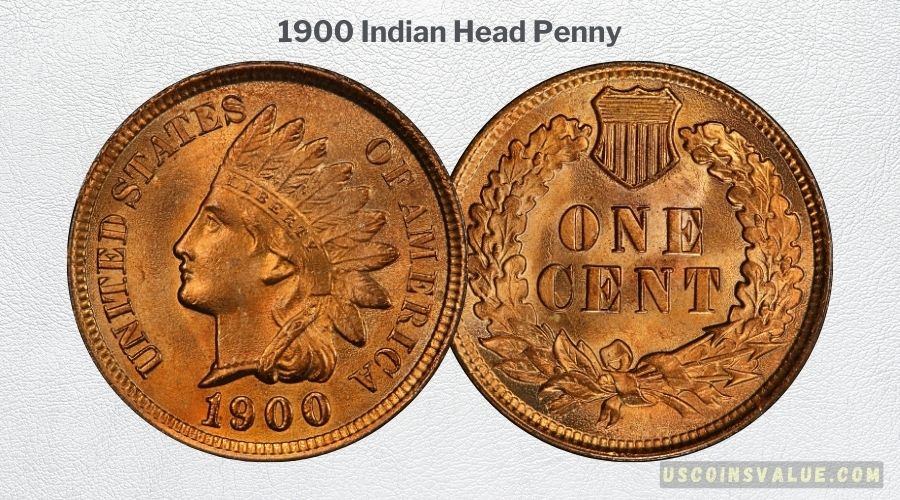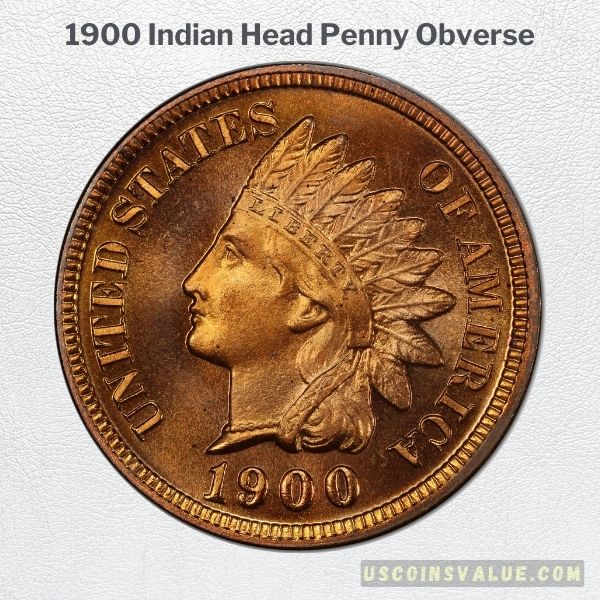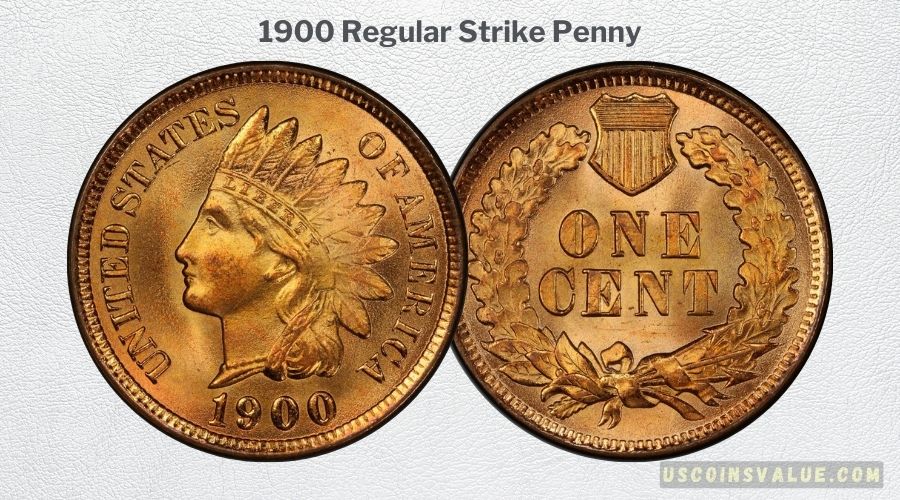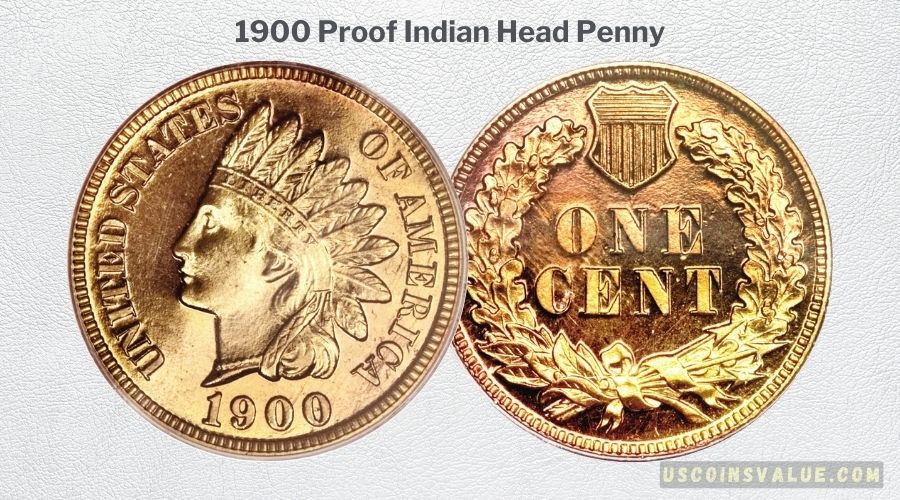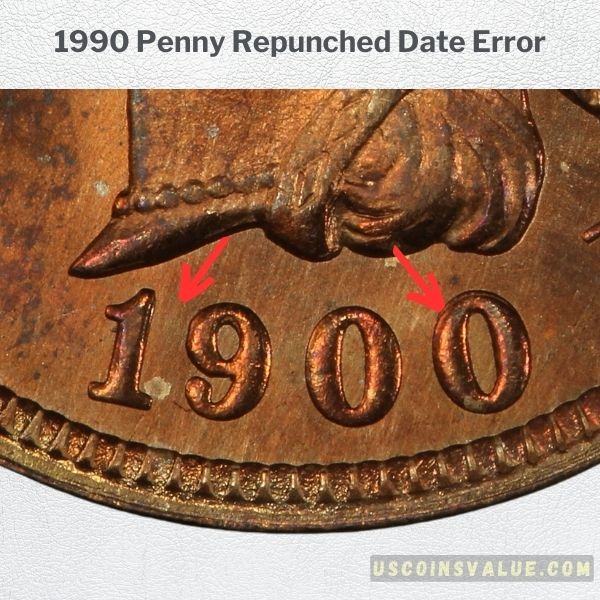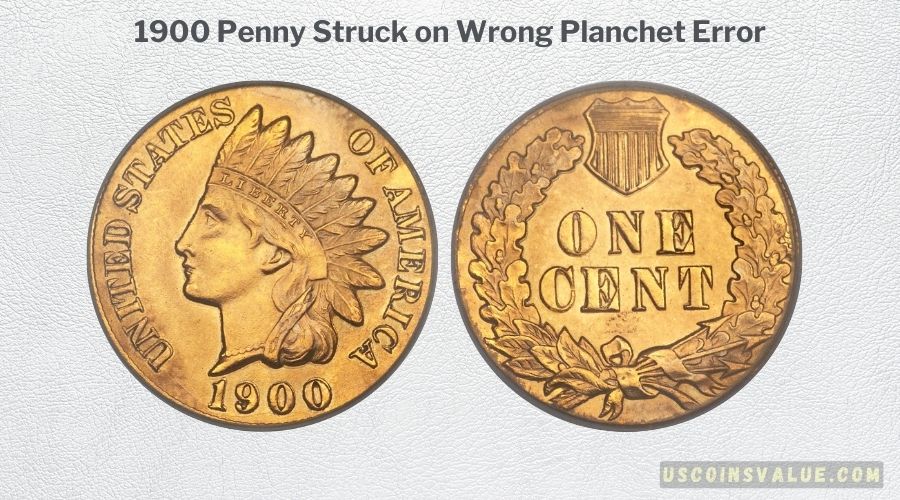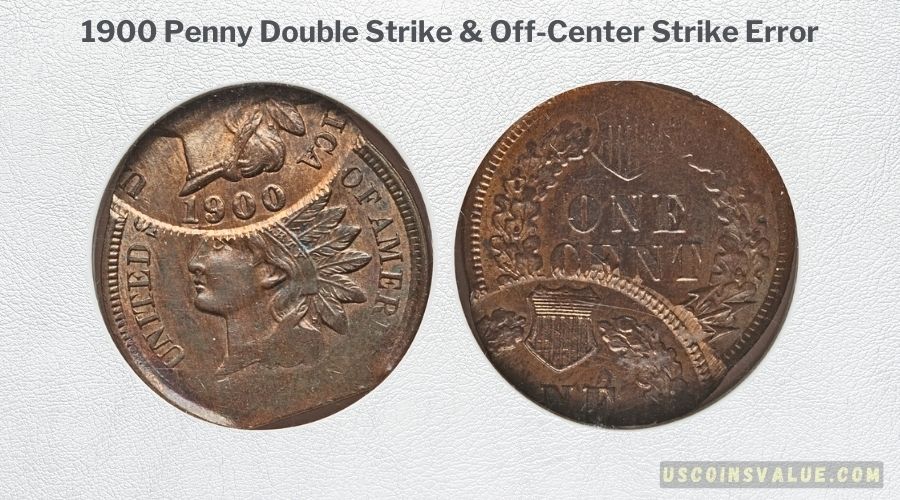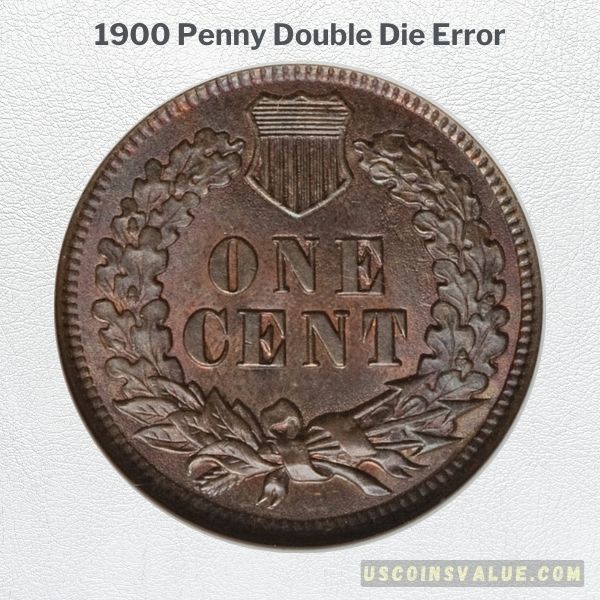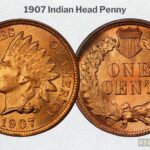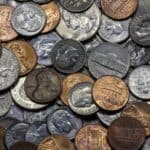Are you trying to determine the value of a valuable 1900 Indian Head Penny in your possession but don’t know where to start?
Or maybe you’re unsure about whether it will be worth anything since it’s over 100 years old. Don’t stress, you’ll get answers to your queries in this piece.
You can buy an average 1900 Indian Head Cent for a minimal $1 fee or as much as $100,000. In 2021, an MS67+ 1900 1C coin sold for $28,200 as the auction record.
Why is there such a large difference in the price value? That’s because the coins weren’t the same grade and variety.
If you are interested in learning about the varieties and valuable 1900 Indian Head Pennies, keep reading.
What is the Background of the 1900 Indian Head Penny?
Indian Head coins reigned supreme in America for 50 years from 1859 – 1909, when the Washington Head took over. During those years, John B. Longacre designed the obverse and reverse, which became popular in the late 1800s until the early 1900s.
Both the regular strike and proof variants of the 1900 Indian Head Cent came from the Philadelphia Mint as the Denver and San Francisco Mints weren’t authorized to produce Indian Head Pennies then.
Because 1900 marked the start of a new century, the Indian Head Penny became a valuable collectible from that year. Every coin collector would appreciate the significance of having an Indian Head Cent from the first year in the 20th century.
The 1900 Indian Head Penny Features
- Series: Indian Head
- Year of Make: 1900
- Mintage: 66,831,502
- Mint Branch: Philadelphia
- Composition: Copper 95%, Tin & Zinc 5%
- Weight: 3.11g
- Diameter: 19 mm
- Edge: Plain
What Does the 1900 Indian Head Penny Look Like?
How can you tell if your 1900 Indian Head Penny is original unless you know what it looks like?
Firstly, there are some words you should know if you’re joining the coin collection world. Obverse means the front, a.k.a. Head, Reverse means the back a.k.a. Tail, and Field means background.
So, on the Obverse, there’s a side profile of an Indian Chief’s head facing left, hence the coin’s name. Many believe the chief is a woman because of the hair tendrils showing underneath the crown.
The crown has nine leaves pointing upward and following the coin’s curve. This coin has a plain edge, but on the field by the diameter, there’s a reeded motif.
- LIBERTY: There’s an inscription of “Liberty” on the crown’s base.
- UNITED STATES OF AMERICA: In front of the chief’s face, there’s a bold “UNITED STATES” while “OF AMERICA” is on the back of her head.
- 1900: The minting year “1900” is beneath the chief’s neck of pearls.
- Mint Mark: There’s no mint mark.
The design on the reverse is different.
- ONE CENT: The coin’s denomination, “ONE CENT” is boldly engraved on the center with “one” above “cent.”
- Leaf Wreath: There’s a leaf wreath woven around “ONE CENT” with a coat of arms shield in the center. The shield sits above “ONE”.
- Arrows in a Ribbon: Beneath “CENT” at the bottom center of the wreath, there are three arrows pointing right, wrapped in a ribbon.
What are the 1900 Indian Head Penny Varieties?
The 1900 Indian Head Penny comes in two main varieties — Regular Strike and Proof. These varieties then have sub-varieties based on color, as you’ll soon learn. Before that, look at this table summarizing the differences between both types.
| 1900 (Indian Head) Varieties | Mintage |
| Regular Strike | 66,831,502 |
| Proof Strike | 2,262 |
1900 Indian Head Penny (Regular Strike)
If you’ve seen different colors of the 1900 Indian Head Penny in regular strikes, you’re not confused. The Philadelphia Mint produced almost 67 million pieces in three colors, including red (RD), red & brown (RB), and brown (BN).
The 1900RD has an earthy clay red color that sometimes leans towards burnt orange. When there’s wear and tear, you’ll notice bronze blotches around the engravings, like the chief’s face on the obverse and the “ONE CENT” on the reverse.
With the 1900BN Indian Head cent, you’ll get a dull, sandy brown color. It hardly loses its tone because this color doesn’t require as much polish as the red or red & brown variants.
The 1900RB Indian Head Cent earned its name from its unique blend of two colors on one coin. Because red and brown fuse into each other on the 1900RB Indian Head cent, the coin looks like a sunset.
You’ll see earthy red on the circumference and sunny yellow at the center.
1900 Indian Head Penny (Proof)
A Proof coin differs from a regular strike because of its purpose and production mode. Unlike the typical(regular strike) Indian Head coin, the 1900 Proof had polished planchets made from special dies. The Philadelphia Mint only issued 2,262 mintage of this variant, making it a rarity.
Interestingly, Proof coins also come in different colors and values. If you get a brown or red & brown piece in PR60 – PR67 grade, you’d make a couple hundred dollars. But if you want five figures, aim for the Cameo variant that falls in the PR63+ to PR70.
You’ll also see the RD, BN, and RB codes in the description to identify the color of your 1900 Indian Head Penny Proof coin. If it’s a cameo design, you’ll see CAM.
1900 Indian Head Pennies with Cameo polishes are shinier and have raised reliefs that preserve the engraving from easy wear and tear.
Let’s discuss how much you can make or lose by trading a 1900 Indian Head Penny.
What’s the Current Value of the 1900 Indian Head Penny?
Although there are lower grades than MS60 for regular strike and PR67 for Proof Indian Head Pennies, they aren’t worth much money. The circulated pieces are available in abundance, thus making them worthless. But the rare pieces are the Mint State ones.
If you want to make some dollars as a seller or wonder how much you’ll spend to start a collection, focus on MS60+ and PR65+ grades.
Before we continue, this table includes the price range for all colors of the regular strike and proof of 1900 Indian Head Penny coins. But note that BN variants are the least valuable and would make you $65 at most for an MS60 piece.
Meanwhile, a proof 1900 Indian Head Cent of that same quality will make you more than double the value at $150. Check out this table for more details.
| Grades | 1900 Indian Head Penny Regular Strike | 1900 Indian Head Penny Proof Coin |
| 60 | $65 – $75 | $150 – $185 |
| 61 | $70 – $85 | $185 – $200 |
| 62 | $75 – $115 | $225 – $450 |
| 63 | $90 – $240 | $260 – $875 |
| 64 | $140 – $450 | $350 – $3,000 |
| 65 | $185 – $1,000 | $1,500 – 7,500 |
| 66 | $575 – $2,750 | $3,250 – $14,500 |
| 67 | $1,000 – $28,500 | $15,000 – $28,800 |
The info on this table is courtesy Professional Coin Grading System (PCGS), Numismatic Guaranty Company (NGC) Coins, and USA Coin Book.
1900 Indian Head Penny Regular Strike
Regular Strike 1900 Indian Head Pennies can fetch as much money as the rarer Proof coin in today’s market. All it requires is the highest rated value, as you’ll see in this table we’ve curated. The record sale stands at $28,200 from 2021 by Legend Rare Coin Auctions.
The following year, Stack’s Bowers sold another MS67+ 1900 Indian Head Penny for $24,000, which was $4,000 shy of the current record.
This year’s many sales haven’t met that record, but they’ve been relatively lucrative. Heritage Auctions made $9,900 and $11,400 in sales on MS67 1900 Indian Head Pennies.
| Grade | Highest Price & Sale Date | Firm |
| MS67, RD | $28,200 (2021) | Legend Rare Coin Auctions |
| MS67+, RD | $24,000 (2022) | Stack’s Bowers |
| MS67, RD | $11,400 (2023) | Heritage Auctions |
| MS67, RD | $3,600 (2022) | Heritage Auctions |
| MS66, RD | $1,400 (2023) | David Lawrence RC |
1900 Indian Head Penny Proof Coin
Now, you know why it’s worth much in the numismatic market.
In 2004, Heritage Auctions sold a Proof 1900 Indian Head Penny graded 67 for $8,625, and Superior Galleries sold one for $6,038 in 1999. The best news is that the glory days aren’t behind.
The auction record for this variety is $28,800 by Stack’s Bowers in 2019, only four years ago.
This year, the record sale is $13,200, half of the 2019 sales but still not a poor figure to make in this economy.
Unverified 1900 Indian Head Proof coins fetched some money in the late 1990s but no longer make money today. For any client to take you seriously, ensure a reputable company values your coin, whether PCGS, NGC, SEGS, or ANACS.
See this table for full details on the current value of Proof 1900 Indian Head Pennies.
| Grade | Highest Price & Sale Date | Firm |
| PR67, CAM | $28,800 (2019) | Stack’s Bowers |
| PR67, RD | $13,200 (2023) | Heritage Auctions |
| PR66+, RB | $3,840 (2021) | Stack’s Bowers |
| PR67, RB | $3,840 (2023) | Heritage Auctions |
| PR66+, RB | $2,520 (2018) | Heritage Auctions |
Common Errors You’ll Find in 1900 Indian Head Penny
Although 1900 Indian Head Cents in MS and PR60+ are worth some thousand dollars, you’ll be surprised at how much more money you could make on error pieces.
Because errors aren’t consistent, coins with such unique mistakes are rare and thus valuable. If you remember the rules of demand and supply, where less supply leads to higher demand, you’ll understand the appeal of 1900 Indian Head Pennies with errors.
Here are some popular vintage and antique coin errors.
- Repunched Date Error (RPD)
- Struck on Wrong Planchet Error
- Double Strike/Off-Center Strike Error
- Double Die Error
Repunched Date Error (RPD)
When a digit on the date of a coin appears more than once or with doubled parts, that’s an RPD error. It results from multiple punching on the coin when the die isn’t thick enough to create visible numbers the first time.
It’s a standard error, but that doesn’t mean you’ll find MS60+ 1900 Indian Head Cents lying around. If you’re lucky enough to find one, it’ll cost you some thousand dollars to possess.
- In 2021, Heritage Auctions sold an MS67 Red 1900 1C with an RPD error for $4,560
- In 2022, another RPD 1900 MS66 1C sold for less at $1,380.
Struck on Wrong Planchet Error
All coins have designated planchets to create uniform designs for each series. But because humans and machines aren’t perfect, the wrong planchet can sometimes feed the “right” strike. This caused the 1900 Indian Cent coin to come out in a different color and size.
In 2015, a 1900 Indian Head cent struck on a gold planchet sold for six figures in dollars at auction. That’s because typically, Indian Head cents were struck on copper, tin, and zinc composite planchets. So, gold wasn’t only rare but valuable.
- Heritage Auctions sold a 1900 1C Struck on $2 ½ Gold Planchet and graded MS65 for $141,000.
- In 1993, Heritage Auction sold an AU55 1900 1C struck on a Gold Planchet for $29,150.
Double Strike a.k.a. Off-Center Strike Error
A 1900 Indian Head Penny is complete after one perfect strike. Unfortunately, during production, sometimes the mechanism moved, causing the strike to hit the surface a second time. This error makes the engravings on the obverse and reverse shift from their position.
Sometimes, the shift can be a few percent off the mark and other times, it can move up to 80% off, causing empty spaces and partial images on the coin.
The Double Strike or Off-Center Strike error coin will still cost you some dollars to collect.
- In 2008, a Double Struck 1900 1C coin with 80% off-center error for $575.
- A 60% off-center strike on a defective planchet with an M64 grade and brown color sold for more at $2,413.20 in 2021.
Double Die Error
The 1900 Indian Head Penny’s composition is complete with a single die coating, but when there’s a problem with production, you can get a double die piece. Double die errors can affect the obverse or reverse or both sides depending on the gravity of the production fluke.
You’ll see the code DDO to indicate a Double Die Obverse error and DDR for the reverse side. When this happens, your coin will have two colors that give the engravings an appearance of double-printing.
- In 2012, a Double Die reverse error MS64 1900RB Indian Head Cent sold for $207.
Final Thoughts
The most lucrative 1900 Indian Head Pennies are those with unique errors. But considering the rarity of finding one, you can still make money by selling a high-grade regular strike or proof piece.
Because of the current economic state, 1900 Indian Head Pennies aren’t bringing in five to six figures like in the past. You can, however, still make a couple thousand dollars.
When you start collecting, we recommend trading via reputable companies like PCGS and NGC Coins. It’s your only guarantee of authenticity. If you must use an online site like eBay, don’t buy an ungraded coin.

